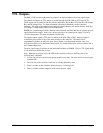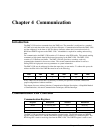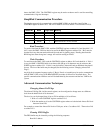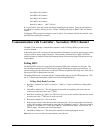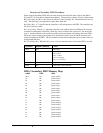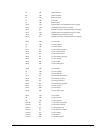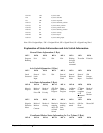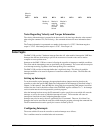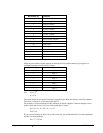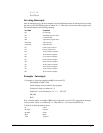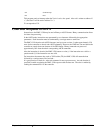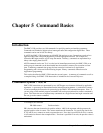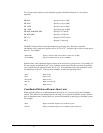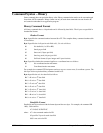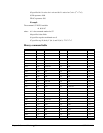
USER MANUAL Chapter 4 Communication • 51
Move in
Progress
BIT 7 BIT 6 BIT 5 BIT 4 BIT 3 BIT 2 BIT 1 BIT 0
Motion is
slewing
Motion is
stopping
due to ST
or Limit
Switch
Motion is
making
final
decel.
Notes Regarding Velocity and Torque Information
The velocity information that is returned in the data record is 64 times larger than the value returned
when using the command TV (Tell Velocity). See command reference for more information about
TV.
The Torque information is represented as a number in the range of +/-32767. Maximum negative
torque is -32767. Maximum positive torque is 32767. Zero torque is 0.
Interrupts
The DMC-13X8 provides 7 hardware interrupt lines that will, when enabled, interrupt the VME host.
Interrupts free the host from having to poll for the occurrence of certain events such as motion
complete or excess position error.
Interrupts on the DMC-13X8 are vectored, allowing the controller to interrupt on multiple conditions.
The vector and the interrupting event are specified by the EI command. The vector must be sent prior
to an interrupt occurring, regardless of the interrupt being UI or conditional.
The DMC-13X8 provides an interrupt buffer that is eight levels deep. This allows for multiple
interrupt conditions to be stored in sequence of occurrence without loss of data. The EI0 clears the
interrupt queue.
Setting up Interrupts
To set the controller up for interrupts, the appropriate hardware jumpers must be placed on the
controller to select the specific IRQ. Hardware configuration for the interrupts is described in Step 2,
Chapter 2 of this manual. Once the IRQ line, along with the corresponding IAD jumpers, have been
selected, the data 2 and 4 should be written to the CONTROL register at address N + 3. An interrupt
service routine must also be incorporated in your host program.
After the interrupt has been set up, the EI command is used to specify the event which will cause the
interrupt, as well as the vector on which the interrupt will occur. The events that will cause an
interrupt are listed below in the Configuring Interrupts section.
Interrupts may also be sent by the user, specified by the UI command. There are 16 of these User
Interrupts that can be sent from the controller, either through a program or through the command line.
The EI command must be used to specify the vector to be used by the UI.
Configuring Interrupts
The events which will cause the controller to send an interrupt are as follows:
The * conditions must be re-enabled after each occurrence.



